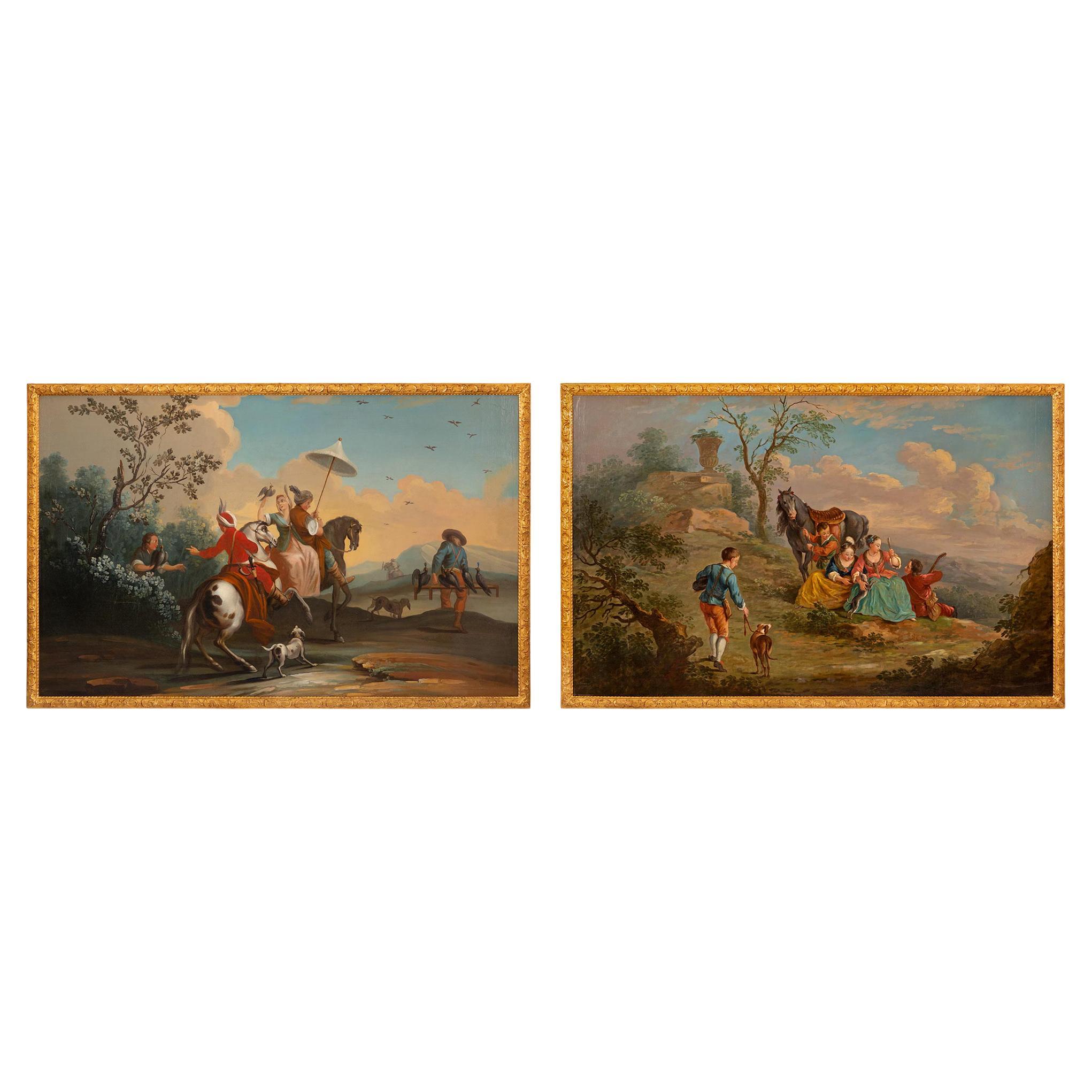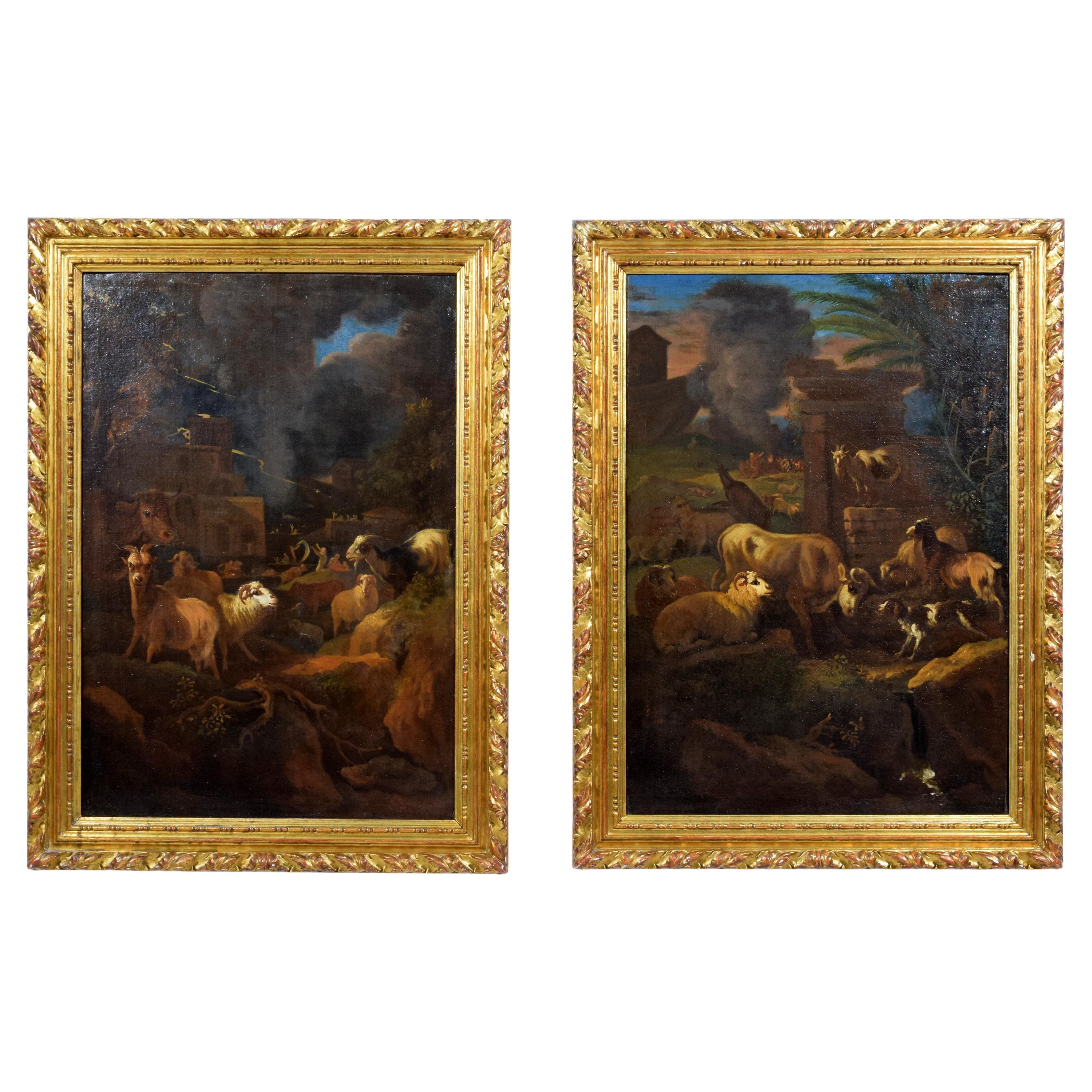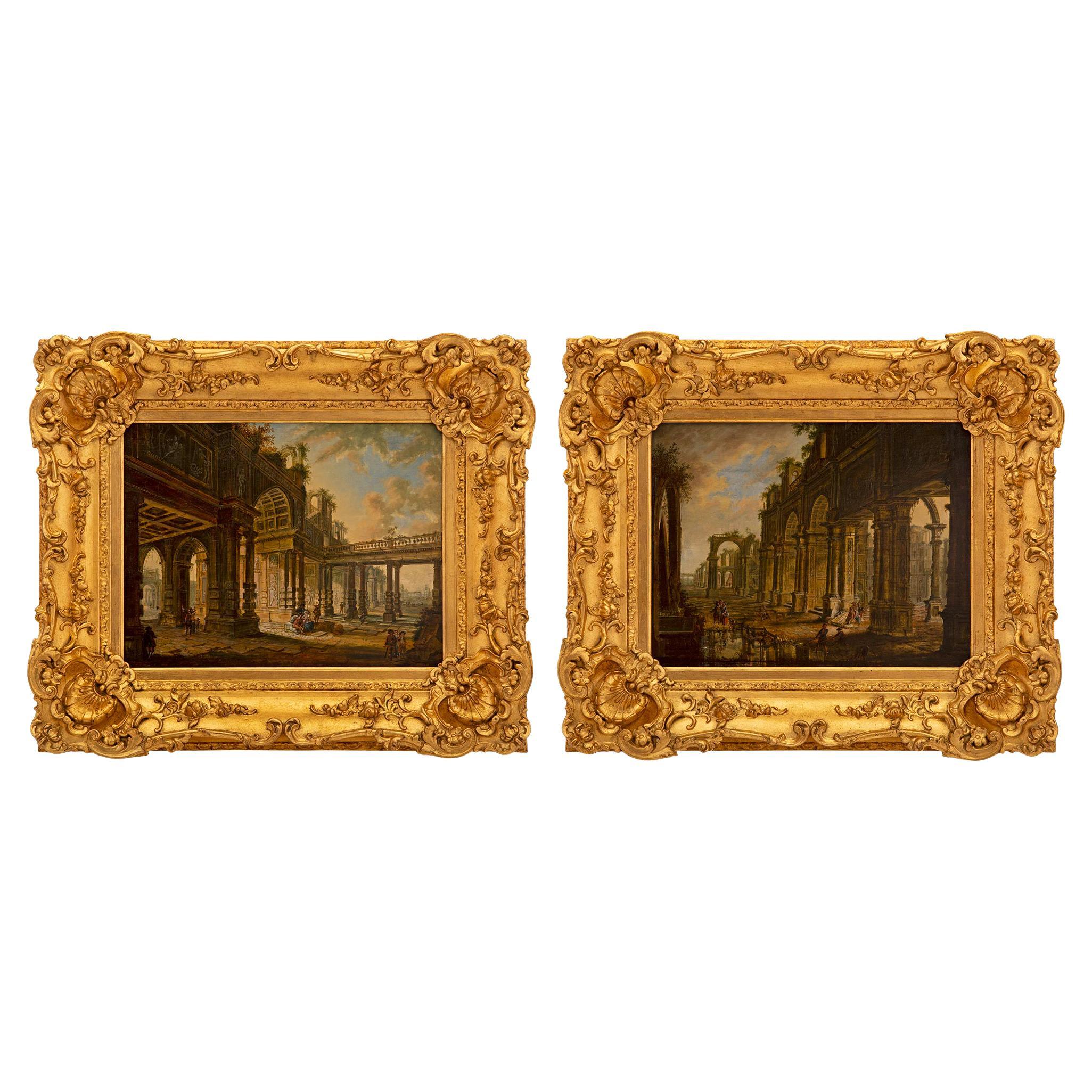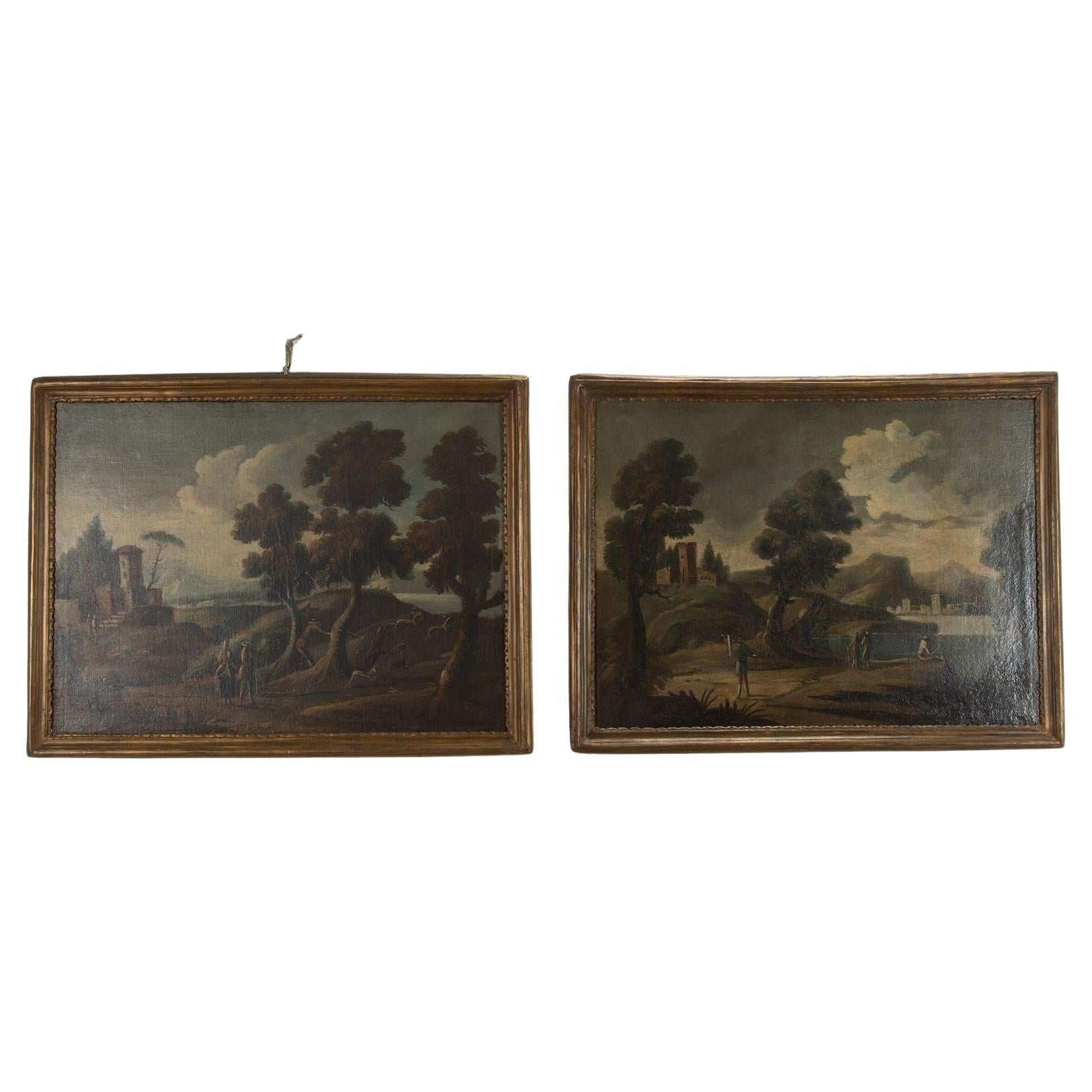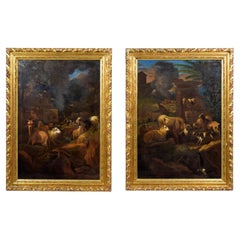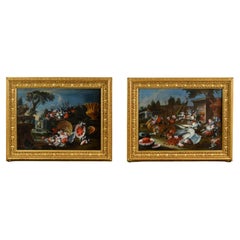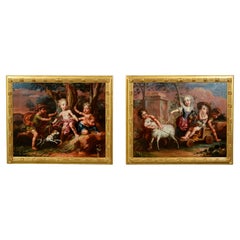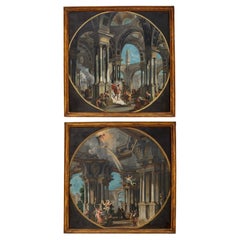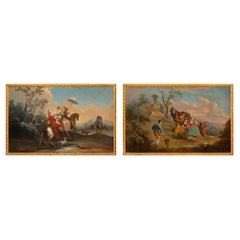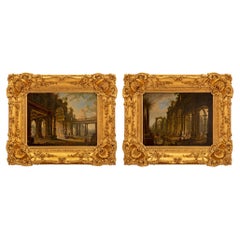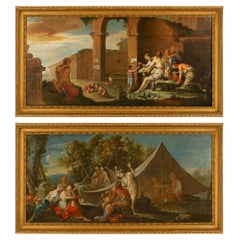Items Similar to 18th Century, Italian Pair of Oil on Canvas Paintings by Francesco Simonini
Want more images or videos?
Request additional images or videos from the seller
1 of 18
18th Century, Italian Pair of Oil on Canvas Paintings by Francesco Simonini
$28,158.31
$43,320.4835% Off
£20,847.09
£32,072.4535% Off
€23,400
€36,00035% Off
CA$38,987.16
CA$59,980.2435% Off
A$42,564.64
A$65,484.0635% Off
CHF 22,314.90
CHF 34,330.6235% Off
MX$516,963.96
MX$795,329.1835% Off
NOK 278,676.77
NOK 428,733.5035% Off
SEK 263,145.18
SEK 404,838.7435% Off
DKK 178,149.20
DKK 274,075.6935% Off
About the Item
Francesco Simonini (Parma, 16 June 1686 - Parma, 1766)
“The rest of the soldiers” and “The march of soldiers”
oil on canvas
cm 40 x 58 and 40 x 60 ; frame: h 52,5 x W 70,5 x D 6 and h 52,5 x W 72,5 x D 6
The very fine paintings, attributable to the painter Francesco Simonini, depict two different moments related to the vein of battles and military themes: “The rest of the soldiers” and “the march of soldiers”.
In one of the paintings you can see on the right in the foreground some soldiers sitting and playing dice, while next to a couple banquets with wine. The scene takes place outdoors, in a countryside, next to a rocky promontory on the top of which dominates a tower. On the left is a couple of gentlemen in noble clothes and a beggar hands them a hat as a sign of alms. In the background, are described other characters including soldiers on horseback and wayfarers, while in the distance you can see a city and a high bell tower. The horizon is outlined by rocky reliefs and other small villages. The blue sky is marked by some white clouds and fluffy.
The other painting depicts, in the lower half of the canvas, a military deployment in which several mounted soldiers are gathered and ready to march. In the distance there is a city with walls and towers beyond which a prominent mountain serves as a fifth to the scene. A few clouds brighten the clear sky.
The genre of painting battles and scenes closely related to the conflict, including the pay and support of troops, advancements and the March of soldiers, found great success in the collections of the Italian and European nobility of the seventeenth and eighteenth centuries. Battle painting was a popular genre and was requested above all by the great aristocratic families, such as the Medici in Florence and the Estensi in Parma, who loved to furnish their living rooms with the paintings of the most important "battallists".
Among these, Francesco Antonio Simonini (1686-1766) distinguished himself, who, after having worked in Parma, Rome, Florence and Bologna, realized most of his works in Venice.
The couple of paintings in this study can be returned with reasonable conviction for stylistic comparison, to the corpus of works of this famous Italian painter.
[…]
His particular style, characterized by rapid brushstrokes and the use of bright colors, is formed mainly under the influence of the Venetian school. Characteristic of his painting is also the tendency to realize elongated and sinuous figures, the attention to the particular landscape and architectural style also Classic, the depth of the landscape that is lost to infinity, the almost indefinite horizon line for the confusion of heaven and earth, the drama and realism in which you notice the influence of Salvator Rosa. It is therefore possible to say that Simonini was able to reinterpret the lesson of his predecessors, enriching it with a Venetian-style coloring, acquired during the long stay in the lagoon city, and with a free and frayed touch, which gives lightness to the composition.
From the stylistic comparison between the works in question and those returned to the catalogue of Francesco Simonini are evident the peculiarities of his painting. The elegant elongated figures treated with sure and quick brushstrokes, the way in which the landscape and the sky are described, the chromatic palette are in fact completely comparable to many other canvases by Simonini. The same applies to the use of white, which the artist expertly uses, creating illuminations and points of light useful to give three-dimensionality to his figures and made material, such as the sparkle of weapons and the soft plumage of hats.
The print of an etching, preserved in Naples and taken from a drawing by Francesco Simonini, clearly shows a composition quite similar to that present in one of the two canvases in question. The mirror vision of the subjects derives from the printing technique itself: the engraving on copper of the drawing takes place on the plate, after which it is upside down and printed on paper producing a symmetrical image.
- Attributed to:SIMONINI (Artist)
- Dimensions:Height: 20.87 in (53 cm)Width: 28.75 in (73 cm)Depth: 2.37 in (6 cm)
- Style:Baroque (Of the Period)
- Materials and Techniques:
- Place of Origin:
- Period:
- Date of Manufacture:Early 18th Century
- Condition:
- Seller Location:IT
- Reference Number:1stDibs: LU4405219623392
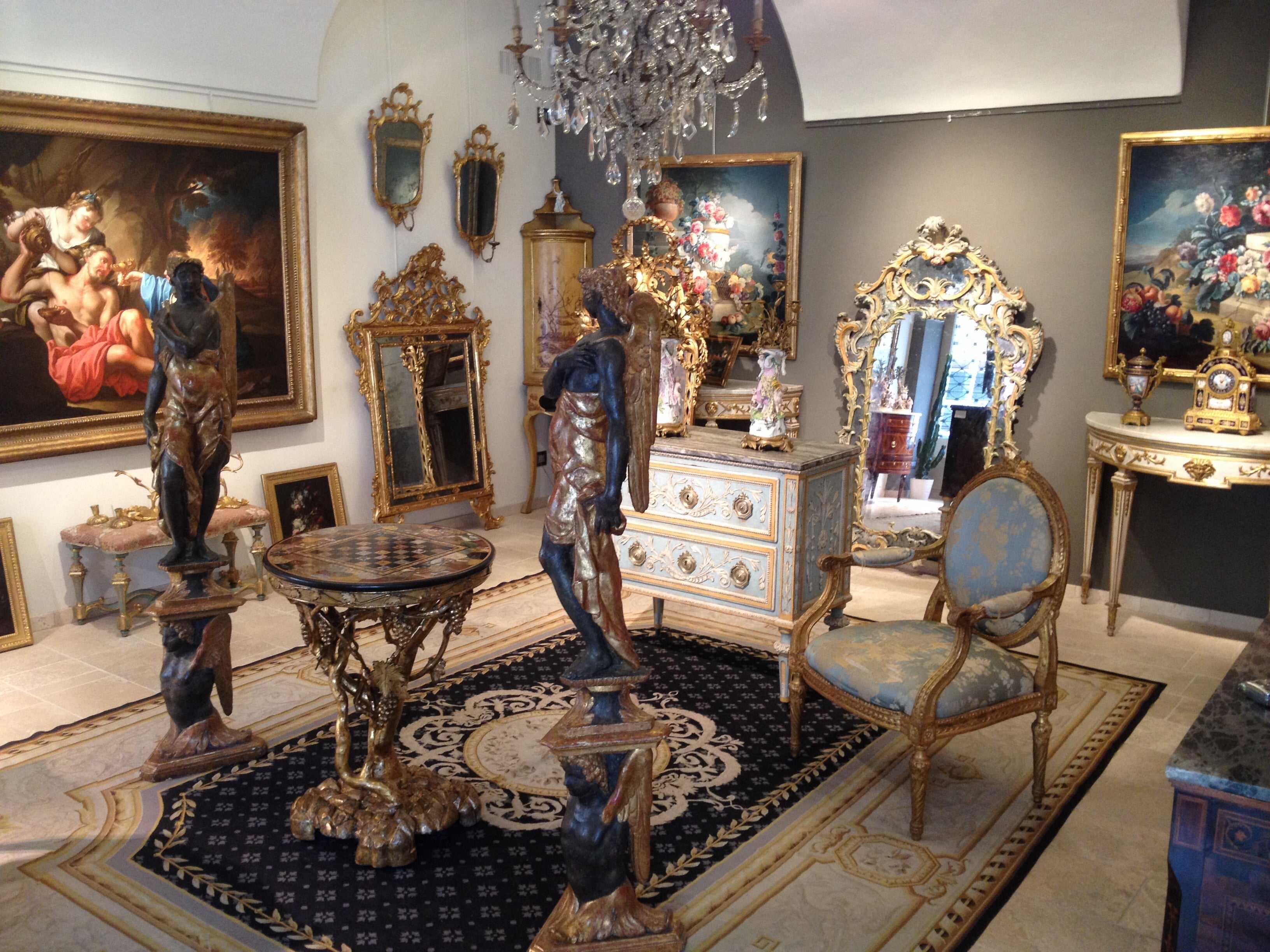
About the Seller
5.0
Platinum Seller
Premium sellers with a 4.7+ rating and 24-hour response times
Established in 1980
1stDibs seller since 2019
56 sales on 1stDibs
Typical response time: <1 hour
- ShippingRetrieving quote...Shipping from: Italy
- Return Policy
Authenticity Guarantee
In the unlikely event there’s an issue with an item’s authenticity, contact us within 1 year for a full refund. DetailsMoney-Back Guarantee
If your item is not as described, is damaged in transit, or does not arrive, contact us within 7 days for a full refund. Details24-Hour Cancellation
You have a 24-hour grace period in which to reconsider your purchase, with no questions asked.Vetted Professional Sellers
Our world-class sellers must adhere to strict standards for service and quality, maintaining the integrity of our listings.Price-Match Guarantee
If you find that a seller listed the same item for a lower price elsewhere, we’ll match it.Trusted Global Delivery
Our best-in-class carrier network provides specialized shipping options worldwide, including custom delivery.More From This Seller
View All1681, Pair of Paintings signed Grechetto da Leone as Govaert G. VAN DER LEEUW
Located in IT
1681, Pair of Paintings signed Grechetto da Leone as Govaert G. VAN DER LEEUW
Oil on Canvas
Dimensions: cm W 91 x H 123 x D 6; canvas: cm W 72 x H 103.5
This pair of fine paintings,...
Category
Antique 1680s Italian Baroque Paintings
Materials
Canvas
18th Century, Pair of Italian Still Life Painting, attr. to Francesco Lavagna
By Francesco Lavagna
Located in IT
Francesco Lavagna (Italy, Naples 1684-1724)
Pair of paintings depicting Still Life composition of flowers and watermelon and garden in the background
The paintings, beautifully mad...
Category
Antique Early 18th Century Italian Baroque Paintings
Materials
Canvas
18Th Century, Pair of Italian Allegory Paintings By Vittorio Amedeo Rapous
By Vittorio Amedeo Rapous
Located in IT
18Th Century, Pair of Italian Allegorical Paintings By Vittorio Amedeo Rapous
Pair of paintings depicting the Allegory of Spring with putti and the Allegory of Autumn with putti, Vi...
Category
Antique Late 18th Century Italian Rococo Paintings
Materials
Canvas
$36,581 Sale Price
20% Off
18th century, Couple of Italian Paintings Capriccio with Mythological Scenes
Located in IT
Couple of architectural capriccio with mythological scenes, oil on canvas, painter from Bologna active in the 18th century
The two large and valuable pantings depict two architectur...
Category
Antique Early 18th Century Italian Baroque Paintings
Materials
Canvas
17th Century, Italian Painting by Pier Francesco Cittadini, Jacob and his Family
Located in IT
Pier Francesco Cittadini (Milan, 1616-Bologna, 1681)
"Jacob and his family go to Egypt"
Oil on canvas, cm 109 x 190 (canvas only)
The valuable painting, made in oil on canvas, depicts Jacob and his family go to Egypt and we believe it can be, given the high quality painting, autograph work of Italian Pier Francesco Cittadini (Italy Milan, 1616 - Bologna, 1681) made after 1647. The work, in excellent condition is accompanied by a coeval frame in wood finely carved and golden.
The scene depicted, which was confused with the Flight to Egypt in the past years, is instead identified with the biblical episode of Jacob’s journey. In the foreground, reading the painting from left to right, we see a caravan composed of animals, including donkeys, dromedaries, goats, dogs and horses and people, women, men and slaves, who carry on their journey along the banks of a river, following a path that to the right, would seem to lead to the through of a bridge. In addition to the watercourse is described an environment characterized by large rocks and impervious come far to cover the entire verticality of the canvas. On the left, in the distance, we see the tail of the caravan that runs along the steep path. Large trees enliven and harmonize the environment, as well as white and grey clouds characterize the predominantly clear sky and illuminated on the right by sunlight.
The story is told in the Bible, Book of Genesis, 30, 25, passage in which is described the flight of Jacob from Haran after the contrasts with Laban, father of his wife Rachel. Jacob is the third great patriarch of the Bible. From his descendants originate the twelve generations of the people of Israel. He is the son of Isaac and Rebekah, who led him to flee from the wrath of Esau to Haran to seek refuge from his brother, Laban. At his uncle’s house Jacob met his daughter Rachel. As soon as he saw his cousin, Jacob was taken. Jacob will stay seven years in the service of Laban to marry his beloved Rachel. But Laban, with a deception, will give him in marriage first Lia, the least beautiful eldest daughter, and only after another seven years the splendid Rachel. From his first wife he will have several children, while Rachel will give birth to the beloved son, Joseph, who will become viceroy of Egypt.
After years of service, Jacob asked to be paid with every dark-coloured garment among the sheep and every spotted and dotted garment among the goats. Laban accepted and sent away from his sons all the leaders of that kind. So Jacob took fresh branches of poplar, almond and plane tree, and flayed them, and put them in the troughs. The optical suggestion induced the goats and the sheep to conceive and give birth to dark, striped and dotted garments. He also ensured that all the strongest and healthiest leaders of the flock of Laban would drink near the barked branches, thus assuring a genetic superiority to his part of the flock. His flocks grew numerous and strong and he became richer than his relative, arousing envy. It was clear that Laban would not respect him much longer. At the suggestion of the Lord, Jacob decided to return to Canaan. Trying to avoid any possible dispute, he left with his family while Laban was absent for shearing sheep. But when, three days later, his uncle returned home, he became angry, feeling offended because Jacob had gone secretly and had not allowed him to greet his daughters and grandchildren. In addition, his teraphim, statuettes, or idols, which depicted the family deities, had disappeared. After 7 days of pursuit, Laban and his men reached Jacob’s group on Mount Gilead, in the mountainous region west of the Euphrates River, where his uncle and grandson had a stormy conversation. The younger man was outraged at being accused of stealing idols and told Labano to rummage through his family’s tents at will. Neither of them could know or even imagine that it was Rachel who took the idols and hid them in the saddle of the camel. During the search, she sat down firmly on the saddle, apologizing for not being able to get up, «because I usually have what happens to women» (Gen 31:35). So the loot wasn’t discovered.
The author of this work was inspired by the composition of an engraving by Stefano Della Bella (1610-1664) of circa 1647. The engraving by Stefano della Bella bears the title "Iacob sur ses vieux jours quitte sans fascherie pour voir son filz Ioseph, sa terre et sa patrie" and is signed on the bottom left "Stef. of the Beautiful In. et fe." while on the right it is declared "Cum privil. Regis", that is with license of the king.
Stefano Della Bella (Italy - Florence, May 18, 1610-Florence, July 12, 1664) was born in a family of painters, sculptors and goldsmiths and was left early orphan of his father sculptor, he dedicated himself first to the art of goldsmith at the school of Giovanni Benedetto Castiglione and Gasparo Mola, then turning his attention to drawing and engraving. He soon began drawing figures and copying the etchings of Jacques Callot, which inspired his early works. Under the protection of the Medici, in particular of Don Lorenzo, cadet son of Grand Duke Ferdinand I, Della Bella has the opportunity to make study trips to Rome, where he stayed from 1633-1636; In Rome he met French engravers and publishers of prints such as Israël Henriet and François Langlois, who influenced his decision to move to Paris in 1639, four years after the death of Callot. In Paris he soon reached, thanks to the engravings commissioned by Cardinal Richelieu, the success also worldly; he frequented courtiers, theatre artists and writers, while refusing too oppressive honors. In 1646-1647 he continued his travels in the Netherlands to Amsterdam, Antwerp and Dordrecht. He returned to Florence in 1650 and resumed working under the protection of the Medici court, working for his patrons. In 1656 he became a member of the Academy of Apatists.
The painting object of this study is reasonably attributable to Pier Francesco Cittadini, or Pierfrancesco Cittadini, called the Milanese or the Franceschino (Italy - Milan, 1616-Bologna, 1681) as some exemplary stylistic comparisons proposed to follow can prove.
Pier Francesco Cittadini was an Italian baroque painter, mainly active in Bologna.
His artistic training first took place with the painter Daniele Crespi...
Category
Antique Mid-17th Century European Baroque Paintings
Materials
Canvas, Giltwood
Couple of Italian Paintings Depicting Capricci, Francesco Aviani ‘1662-1715’
Located in IT
Francesco Aviani (Italy - Venice, 25-11-1662 / 1715) att.
Couple of paintings depicting Capricci
Oil on canvas, 135 x 183 cm, without frame
The two large and fine paintings depict two illusionistic architectural renderings, with views of colonnades and arched buildings, animated by figures. The compositions are characterized by the harmony with which the painter introduces the sumptuous architectural monuments, the mirrors of water, the buildings in the distance and the views of the landscape. Dominates with a color on the tones of brown and ochre that stands out on the blue sky, marked by some cloud of steam. The insertion of the figures to enliven the architectural views also balances with the set.
The Capriccio, an artistic genre that has made its way into Italian painting since the 17th Century, is characterized by the representation of fantastic architectures or prospective inventions, sometimes combined with elements drawn freely from reality. The two paintings are an example of this type and they are a very interesting and Fine artwork.
The remarkable pictorial quality emerges both from the composition of the ensemble and from the way in which the artist describes the views with great attention to detail, highlights and refined, perfectly realistic, chiaroscuro.
The same must be recognized for the figures: these are described with a wise brushstroke, quick and quick touches give the dynamism of the moment that is captured, as if time had stopped to show and narrate what is happening.
The painting on the right represents a large Baroque building in stone and paved with marbles, two floors, with moving façade, large columns with corinthian columns, a large portal with a staircase with large footsteps, a balustrade with string, from which some figures appear, and two equestrian monuments in bronze. The sumptuous building overlooks a large POOL of water, with a gushing fountain, around which some characters sit. In the second floor is described a white palace from which rises a tower crowned by a structure with wrought iron loggia. In addition there is a bridge and some architectural ruins behind which some mountainous reliefs fade towards the horizon.
On the staircase is described a particular scene. The people seem to be part of a very precise story. A woman, in the shadow of a parasol supported by a servant, would seem to drive out of the palace a man, who, taken under his arm by two maidens with a determined attitude, is led to a boat.
The scene could be identified with the biblical episode of the parable of the prodigal son (Luke 15,11-32), at the moment when the prodigal son is robbed and driven away by the harlots.
The episode tells of a man with two children. The youngest said to his father: “Father, give me the part of my inheritance”. And the father divided the substances. After not many days, the youngest son, collected his things, left for a far country and there he lost his substances with prostitutes and living as a debaucher. When he had spent everything, there came a great famine in that country and he began to find himself in need. Reduced to hunger, he was forced to be a pig herder to survive. He therefore meditated in his heart to go to his father and ask for his forgiveness and to be welcomed anew, even as a servant.
While still on the road, however, the father saw him and ran towards him, receiving him with open arms. He then ordered his servants to prepare a great feast for the occasion, killing for the purpose the "fatty calf". The firstborn did not understand why his brother was given such treatment, and reminded the parent that he, who had always obeyed him, had never received a single kid to celebrate with his friends. The father answered him: «Son, you are always with me and everything that is mine is yours; but it was necessary to celebrate and rejoice, because this brother of yours was dead and came back to life, was lost and was found».
The parable of the prodigal son was often portrayed in painting and the scene he finds most is certainly that of returning home in his father’s arms. Among the many is a canvas by the famous painter Giovanni Paolo Pannini (or Panini) (Italy – Piacenza, 1691– Rome, 1765) kept at the Hallsborough Gallery in London.
Rather rare, however, is the scene of the prodigal son driven and robbed by harlots. There is an engraving by Hans Collaert II (1561-1620) in which this moment is described in the background compared to the moment, narratively later, in which he is penitent among the pigs.
The second painting, certainly pendant of the first, represents a similar palace, with some characters overlooking the balustrade marcapiano and other figures around the large bathtub quadrilobata. In the foreground is described a monument with two large stone sculptures. In the distance some architectural elements and, beyond, the mountains are lost on the horizon.
The studies related to the numerous painters of architectural views and caprices, active in Italy, and the archival documents found, which could better clarify commissions, biographies and certain works, are scarce and sporadic. Therefore there are still many difficulties in reconstructing a catalogue of autograph works for each author. Through paintings in private collections, in museums and paintings passed on the antique market it is however possible to advance some attributions in order to better delineate the various artistic figures.
The style of the works studied here leads to a dating that runs between the 17th and 18th Centuries, with obvious influences dictated by the perspectives of the brothers Galli Bibiena. The analysis of the architectures and the chromatic palette suggests that we are in the presence of a northern Italian and Venetian author. Observing the decorations and the volutes, the brightness and the perspective disposition in fact, we find several analogies with those used by the Vicenza painter Francesco Aviani, excellent in pictorial perspective and architectural views.
The biographical profile of Francesco Aviani (Italy - Vicenza, 1662-1715) was essentially traced in 1956 by Andreina Ballarin, then re-visited by Federica Spadotto in 2014 and Giancarlo Sestieri in 2015. Certain documents about his life are scarce, as are the documented works.
He was born in Venice, probably on 25 November 1662, to Bernardo and a Magdalene whose surname is unknown, and was baptized on 3 December 1662. Between 1701 and 1703 he worked, together with his brother MarCo, sculptor, for the fresco decoration (now illegible) of the church villa in Soella (Vicenza). On October 16, 1703 he married Isabella Carcano. On March 26, 1715 he made a will and died on April 3 of the same year, in Vicenza.
The frescoes in the refectory of the sanctuary of Monte Berico in Vicenza are considered authentic works by Aviani, probably made in 1708; the paintings preserved in the Civic Museum of Vicenza: “Landscape with Lazzaro and the rich Epulone”; “Christ among the doctors”; “The miraculous fishing”, works not datable but with attribution corroborated by style. In addition, the frescoes in the east and west corridors of the Villa La Rotonda, near Vicenza; the fresco in the apse basin of the chapel of the church S. Croce, Vicenza, now destroyed; the frescoes of the central hall of Villa Camerini a Montruglio (1714) and a painting of a “Porto Regio”, of which we have a print engraved by Dall'Acqua.
From his works emerges the artistic background that animated the Venetian culture in the early eighteenth century. The scenic grandeur with which Aviani treats the architecture also suggests a stay in Emilia of the painter, in which he could have come into contact with the environment of the Bibiena. These contacts would be confirmed by the press of Cristoforo Dall'Acqua (Vicenza 1734-1787), “Il porto regio”, after a painting of Aviani. The press was part of a group of engravings, representing royal buildings, reproducing paintings of the Bibiena. In the eyes of Dall’Acqua, therefore, Aviani’s work was not foreign among those of the Emilians.
Inside the sumptuous architectural whims, Aviani often depicts biblical scenes, in which the characters share the space and the narrative rhythm, along with figures drawn from everyday scenes, memories of the Veronese and Bassano heritage. Also in the works covered by this study the author does not seem to want to give up a biblical subject, though the purpose of the paintings appears to be clearly a staging scenography-architectural within which the characters are relegated to the role of extras.
From the examination of the architectural Capriccio gathered under the name of Aviani then emerge common elements. The comparison between these works and the works in question highlights the proximity of the compositions. The imposing and scenic architectures are in fact equally characterized by the perspective-scenographic ability diffused in emilian “quadraturisti” and in Bibiena work. In fact, you can see the spectacular slender architecture in the lower part, the loggias that create chiaroscuro games with arches and binate columns placed on massive bases and overhung by projecting cornices.
Significant also the comparison with two paintings with architectural whims in a night vision attributed to Francesco Aviani.
In Aviani’s works it is possible to find a certain knowledge of the Roman Codazzi paint nd its early development of the eighteenth century, developed with the Locatelli, the Pannini and the less known Domenico Roberti. To Roberti have been recently attributed two works that have some compositional affinity with the canvases in question. The same can be done for a work on the antique market, attributed to Pietro Francesco...
Category
Antique Late 17th Century Italian Baroque Paintings
Materials
Canvas
You May Also Like
Pair of Continental 19th Century Oil on Canvas Paintings
Located in West Palm Beach, FL
A striking and most charming pair of continental 19th century oil on canvas paintings. Each beautiful painting is set within its original giltwood frame with finely carved wrap aroun...
Category
Antique 19th Century Unknown Paintings
Materials
Canvas, Giltwood
Pair of French 19th Century Oil on Canvas Paintings
Located in West Palm Beach, FL
A stunning pair of French 19th century oil on canvas paintings attributed to Jean-Baptiste Huet. Each painting is set within its origi...
Category
Antique 19th Century French Paintings
Materials
Canvas, Wood
$64,500 / set
Pair of Swiss 18th Century Baroque St. Oil on Oak Paintings
Located in West Palm Beach, FL
A stunning and exceptionally well executed pair of Swiss 18th century Baroque st. oil on oak paintings by Christian Stocklin. Each Architectural Capriccios ...
Category
Antique 18th Century Swiss Baroque Paintings
Materials
Oak, Giltwood, Paint
Pair of Italian 17th Century Oil on Canvas Paintings by Antonio Travi
Located in West Palm Beach, FL
A stunning pair of Italian 17th century oil on canvas paintings by Antonio Travi. Each painting displays an impressive array of rich colors, typical of T...
Category
Antique 17th Century Italian Paintings
Materials
Canvas, Giltwood
Pair of 18th Century Italian Landscape Paintings
Located in Gloucestershire, GB
Pair of 18th Century framed Italian landscape oil on canvas paintings.
With well observed depictions of pastoral life and well framed in period gilt frames.
Category
Antique 18th Century Italian Baroque Paintings
Materials
Canvas, Wood, Paint
$10,746 / set
Pair of Italian 18th Century Oil on Canvas within Molded Edge Giltwood Frame
Located in West Palm Beach, FL
A superb pair of Italian 18th century Oil on Canvas paintings in their original giltwood frames. The painting on the left depicts large impressive battle ships in the back ground and...
Category
Antique 18th Century Italian Paintings
Materials
Canvas, Giltwood
More Ways To Browse
European Harbor Paintings
French Painting Silk
Italian Reverse Glass Painting
Kamasan Painting
Lucien Beniere
Madrid Spain Painting
Oriental Girl
Oval Italian Painting
Painting With Plaque
Paintings By Florida Artists
Paintings From 1800s
Patrick Phillips Paintings
Philip Michaels
Romantic Period Furniture
Scroll Wall Hanging
Used Beach Umbrellas
Venezia Italy Painting
Vintage Chinese Reverse Glass Painting
